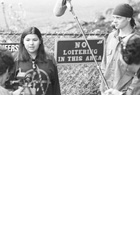
No Loitering 2001
Distributed by New Day Films, 22-D Hollywood Ave. Hohokus, NJ 07423; 888-367-9154
Produced by Ellen Frankenstein
Directed by Ellen Frankenstein
VHS, color, 56 min.
Sr. High - Adult
Adolescence, Social Work, Sociology, Psychology
Date Entered: 11/09/2018
Reviewed by Michele M. Arcury, E. H. Butler Library, Buffalo State College, Buffalo, NYIn this documentary, teenagers residing in a small rural town in Alaska are given a video camera and instructed to film aspects of their day to day lives while providing insight into their perceptions of the world in which they live. We see these young adults doing the things they love to do; the things they are passionate about, from painting to making music, while they discuss their feelings about their town and the direction in which their lives are heading. Attitudes range from the very painful (“pain makes you feel real”) to the optimistic (“it’s all what you make of it”).
Adults viewing this film (especially those who work with teenagers) should take note of the teenagers’ perceptions of how they are treated by adults. The name of the film derives from the belief among the teens that there are “no loitering” signs posted all over town, directed toward them. Many believe they are viewed as second-class citizens. Also noteworthy is the teenagers’ attitudes toward adults. Adults are described as untrustworthy and perceived as having a tendency to make things complicated.
For adults, No Loitering demonstrates the uniqueness and individuality of teenagers, while proving to teenagers that many of their feelings, attitudes and issues are universal among their peers, regardless of where they grow up. The only weakness found is a lack of insight into the teen’s lives at school. Although the intent is probably to show the teens in an element where they are most comfortable, school plays such a large part of their lives it is an obvious omission.
The quality of the audio and video is good. The teens are allowed to tell their story with minimal narration, resulting in a documentary that the teens can be proud of creating.
This film would be an asset to an academic library with social work, sociology, psychology, or education collections. Secondary school libraries and public libraries may want to have this film available for parents, teenagers, family counselors, social workers or youth group leaders.